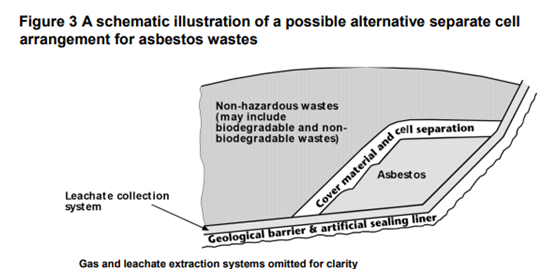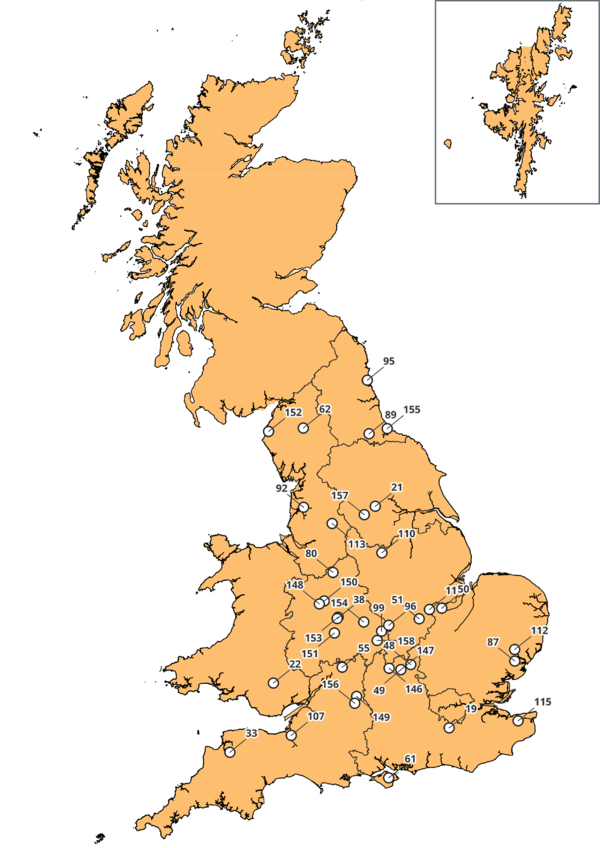Stabilised Non-Reactive Hazardous Waste: Difference between revisions
m minor text change |
change category |
||
| (7 intermediate revisions by 2 users not shown) | |||
| Line 1: | Line 1: | ||
[[Category: | [[Category:Technologies & Solutions]] | ||
A [[Non-Hazardous Landfill]] can receive [[Stabilised Non-Reactive Hazardous Waste]] if certain criteria are met, including acceptance limits and the requirement that any cell which receives this material is separated from cells receiving Biodegradable Waste. This includes Gypsum waste and high Sulphate waste (such as [[Plasterboard]]) within acceptance limits to prevent the 'unacceptable emissions of hydrogen sulphide gas'. If the acceptance limits for 'high sulphate bearing wastes' are exceeded then the material must go to a [[Hazardous Landfill]]. | A [[Non-Hazardous Landfill]] can receive [[Stabilised Non-Reactive Hazardous Waste]] ([[SNRHW]]) if certain criteria are met, including acceptance limits and the requirement that any cell which receives this material is separated from cells receiving Biodegradable Waste. This includes Gypsum waste and high Sulphate waste (such as [[Plasterboard]]) within acceptance limits to prevent the 'unacceptable emissions of hydrogen sulphide gas'. If the acceptance limits for 'high sulphate bearing wastes' are exceeded then the material must go to a [[Hazardous Landfill]]. | ||
The most recent UK guidance on the [[Landfill Directive]] and the [[Landfill]] of Stabilised Non-Reactive Hazardous Waste that sets out the requirements is LFD1 Understanding the Landfill Directive<ref>[https://www.gov.uk/government/publications/understanding-the-landfill-directive-lfd-1] LFD1 Understanding the Landfill Directive</ref> is published by the [[EA]] and referred to by the other regulatory bodies in the UK. | ==Arrangements== | ||
A [[Non-Hazardous Landfill]] can receive [[Stabilised Non-Reactive Hazardous Waste]] ([[SNRHW]]) if certain criteria are met, including acceptance limits and the requirement that any cell which receives this material is separated from cells receiving Biodegradable Waste. This includes Gypsum waste and high Sulphate waste (such as [[Plasterboard]]) within acceptance limits to prevent the 'unacceptable emissions of hydrogen sulphide gas'. If the acceptance limits for 'high sulphate bearing wastes' are exceeded then the material must go to a [[Hazardous Landfill]]. The WikiWaste page '''[[Landfill]]''' frames these types of sites and puts them into a wider context, with the diagrams below setting out how the cell separation can be delivered. | |||
The most recent UK guidance on the [[Landfill Directive]] and the [[Landfill]] of Stabilised Non-Reactive Hazardous Waste that sets out the requirements is LFD1 Understanding the Landfill Directive<ref>[https://www.gov.uk/government/publications/understanding-the-landfill-directive-lfd-1] LFD1 Understanding the Landfill Directive</ref> is published by the [[EA]] and referred to by the other regulatory bodies in the UK. | |||
Two figures for possible separation of cells are included in the guidance and are repeated below: | Two figures for possible separation of cells are included in the guidance and are repeated below: | ||
| Line 9: | Line 12: | ||
|- | |- | ||
| [[File:Figure 1 Non Haz Landfill Stabilised non-reacitve waste.png |800px|center | Figure 1 from Guidance LFD1 Published by the Environment Agency]] | | [[File:Figure 1 Non Haz Landfill Stabilised non-reacitve waste.png |800px|center | Figure 1 from Guidance LFD1 Published by the Environment Agency]] | ||
|- | |||
| [[File:Figure 2 Non Haz Landfill Stabilised non-reacitve waste.png |800px|center | Figure 2 from Guidance LFD1 Published by the Environment Agency]] | |||
|} | |} | ||
| Line 18: | Line 22: | ||
|} | |} | ||
==Capacity Non-Hazardous Landfill with Stabilised Non-Reactive Hazardous Waste== | |||
The capacity of [[Non-Hazardous Landfill]] which has a cell or cells for [[Stabilised Non-Reactive Hazardous Waste]] is also reported by the EA and is summarised in the graph and table below (although the proportion of the total which is Stabilised Non-Reactive Hazardous Waste is generally relatively small). Note that Hazardous Landfill also provides Inert Landfill capacity in the sense that these waste are used for daily cover and site engineering purposes. | |||
The number of [[Non-Hazardous Landfill]] with a [[Stabilised Non-Reactive Hazardous Waste|SNRHW]] cell (ref. L02) sites in England in 2020 was 30, an increase of 1 on 2019. In Wales there was only 1 site (excluded from the capacity set out below) and in Scotland this classification is not used for landfill. | |||
{|style="margin: auto;" | |||
|+style="caption-side:bottom;"|Changes in Non-Hazardous Landfill Capacity with Stabilised Non-Reactive Hazardous Waste Cell | |||
|- | |||
| <graph>{ | |||
"width":400, | |||
"height":200, | |||
"data":[{ | |||
"name":"table", | |||
"values":[ | |||
{"x":2015,"y":89.4},{"x":2016,"y":85.3},{"x":2017,"y":82.9}, | |||
{"x":2018,"y":75.1},{"x":2019,"y":69.4},{"x":2020,"y":67.0} | |||
] | |||
}], | |||
"scales": [ | |||
{ | |||
"name": "x", | |||
"type": "linear", | |||
"range": "width", | |||
"zero": false, | |||
"domain": {"data": "table", "field": "x"} | |||
}, | |||
{ | |||
"name": "y", | |||
"type": "linear", | |||
"range": "height", | |||
"nice": true, | |||
"domain": {"data": "table", "field": "y"} | |||
} | |||
], | |||
"axes": [ | |||
{"type": "x", "scale": "x", "format":"d","title":"Year"}, | |||
{"type": "y", "scale": "y", "grid":true, "title":"Million Cubic Metres"} | |||
], | |||
"marks": [ | |||
{ | |||
"type": "line", | |||
"from": {"data": "table"}, | |||
"properties": { | |||
"enter": { | |||
"x": {"scale": "x", "field": "x"}, | |||
"y": {"scale": "y", "field": "y"}, | |||
"stroke": {"value": "steelblue"}, | |||
"strokeWidth":{"value":2} | |||
} | |||
} | |||
}, | |||
{ | |||
"type": "symbol", | |||
"from": {"data": "table"}, | |||
"properties": { | |||
"enter": { | |||
"x": {"scale":"x","field": "x"}, | |||
"y": {"scale":"y","field": "y"}, | |||
"fill": {"value": "steelblue"}, | |||
"size":{"value":15} | |||
} | |||
} | |||
} | |||
] | |||
}</graph> | |||
|- | |||
{|class="wikitable" style="margin: auto;" | |||
|- | |||
|+Table Summarizing Graph Data | |||
|'''Year''' || 2015 || 2016 || 2017 || 2018|| 2019 || 2020 | |||
|- | |||
|'''Million Cubic Metres''' || 89.4 || 85.3 || 82.9 || 75.1 || 69.4 || 67.0 | |||
|} | |||
|} | |||
==Operational Landfills== | |||
{{#clear_external_data:}} | |||
{{#get_db_data: db=engy |from=lfsites| where=classification='SNRHW' |data=site=site,id=id,operator=operator}} | |||
[[File:LF map snrhw.png|600px|right]] | |||
{|Class="wikitable sortable" | |||
! ID !! Site Name !! Operator | |||
{{#for_external_table:<nowiki/> | |||
{{!}}- | |||
{{!}} {{{id}}}. | |||
{{!}} [[{{{site}}}]] | |||
{{!}} [[{{{operator}}}]] | |||
}} | |||
|} | |||
<br clear="all" /> | |||
==References== | ==References== | ||
<references /> | <references /> | ||
Latest revision as of 16:35, 28 April 2022
A Non-Hazardous Landfill can receive Stabilised Non-Reactive Hazardous Waste (SNRHW) if certain criteria are met, including acceptance limits and the requirement that any cell which receives this material is separated from cells receiving Biodegradable Waste. This includes Gypsum waste and high Sulphate waste (such as Plasterboard) within acceptance limits to prevent the 'unacceptable emissions of hydrogen sulphide gas'. If the acceptance limits for 'high sulphate bearing wastes' are exceeded then the material must go to a Hazardous Landfill.
Arrangements
A Non-Hazardous Landfill can receive Stabilised Non-Reactive Hazardous Waste (SNRHW) if certain criteria are met, including acceptance limits and the requirement that any cell which receives this material is separated from cells receiving Biodegradable Waste. This includes Gypsum waste and high Sulphate waste (such as Plasterboard) within acceptance limits to prevent the 'unacceptable emissions of hydrogen sulphide gas'. If the acceptance limits for 'high sulphate bearing wastes' are exceeded then the material must go to a Hazardous Landfill. The WikiWaste page Landfill frames these types of sites and puts them into a wider context, with the diagrams below setting out how the cell separation can be delivered.
The most recent UK guidance on the Landfill Directive and the Landfill of Stabilised Non-Reactive Hazardous Waste that sets out the requirements is LFD1 Understanding the Landfill Directive[1] is published by the EA and referred to by the other regulatory bodies in the UK.
Two figures for possible separation of cells are included in the guidance and are repeated below:
 |
 |
Asbestos Waste can be deposited in a separate cell, but only if it is sufficiently self contained and designed not to be disturbed in the future, as shown in the following figure from the guidance:
 |
Capacity Non-Hazardous Landfill with Stabilised Non-Reactive Hazardous Waste
The capacity of Non-Hazardous Landfill which has a cell or cells for Stabilised Non-Reactive Hazardous Waste is also reported by the EA and is summarised in the graph and table below (although the proportion of the total which is Stabilised Non-Reactive Hazardous Waste is generally relatively small). Note that Hazardous Landfill also provides Inert Landfill capacity in the sense that these waste are used for daily cover and site engineering purposes.
The number of Non-Hazardous Landfill with a SNRHW cell (ref. L02) sites in England in 2020 was 30, an increase of 1 on 2019. In Wales there was only 1 site (excluded from the capacity set out below) and in Scotland this classification is not used for landfill.
| <graph>{
"width":400, "height":200, "data":[{ "name":"table", "values":[ {"x":2015,"y":89.4},{"x":2016,"y":85.3},{"x":2017,"y":82.9}, {"x":2018,"y":75.1},{"x":2019,"y":69.4},{"x":2020,"y":67.0} ] }], "scales": [ {
"name": "x",
"type": "linear",
"range": "width",
"zero": false,
"domain": {"data": "table", "field": "x"}
},
{
"name": "y",
"type": "linear",
"range": "height",
"nice": true,
"domain": {"data": "table", "field": "y"}
}
], "axes": [ {"type": "x", "scale": "x", "format":"d","title":"Year"},
{"type": "y", "scale": "y", "grid":true, "title":"Million Cubic Metres"}
], "marks": [ {
"type": "line",
"from": {"data": "table"},
"properties": {
"enter": {
"x": {"scale": "x", "field": "x"},
"y": {"scale": "y", "field": "y"},
"stroke": {"value": "steelblue"},
"strokeWidth":{"value":2}
}
}
},
{ "type": "symbol",
"from": {"data": "table"},
"properties": {
"enter": {
"x": {"scale":"x","field": "x"},
"y": {"scale":"y","field": "y"},
"fill": {"value": "steelblue"},
"size":{"value":15}
}
}
} ] }</graph> |
| Year | 2015 | 2016 | 2017 | 2018 | 2019 | 2020 |
| Million Cubic Metres | 89.4 | 85.3 | 82.9 | 75.1 | 69.4 | 67.0 |
Operational Landfills

